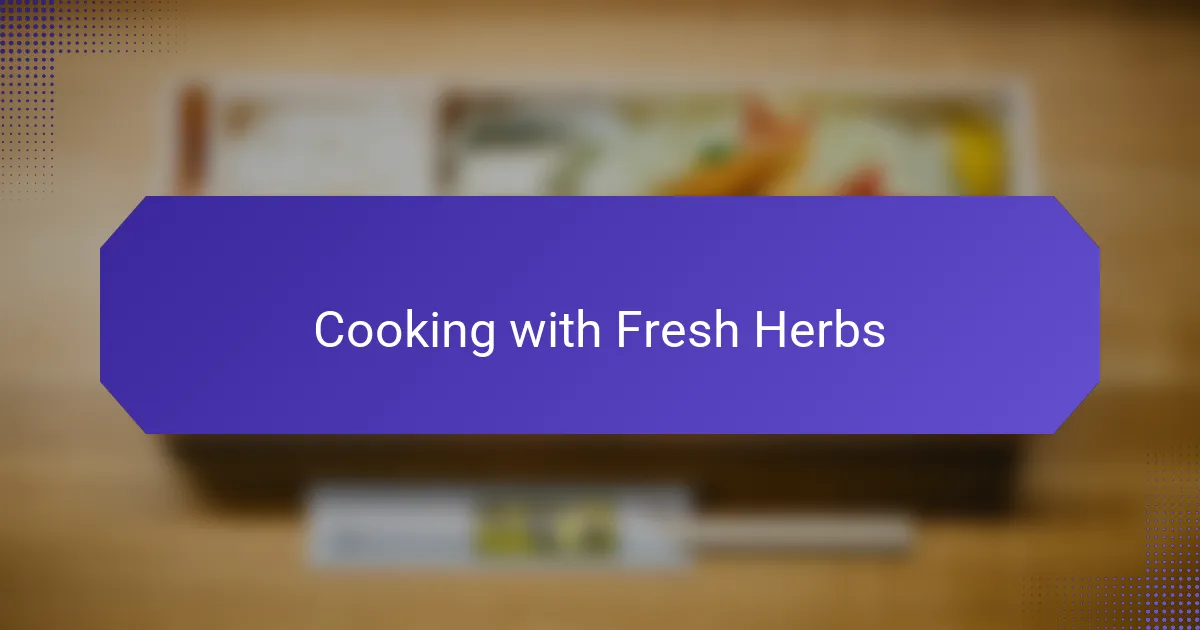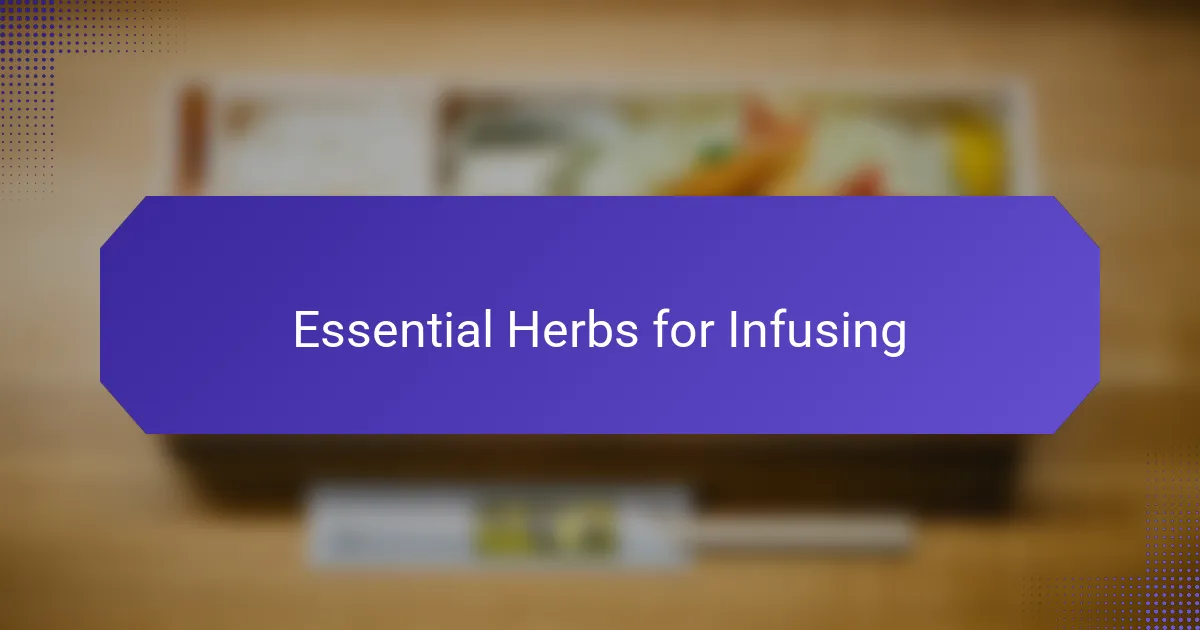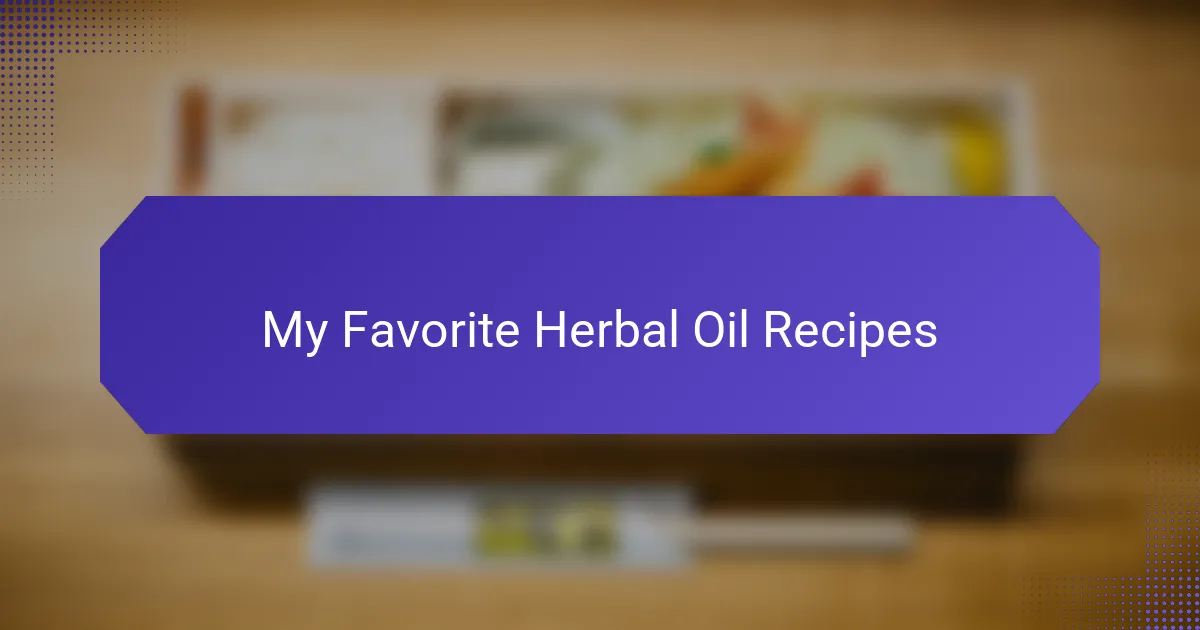Key takeaways
- Using fresh herbs enhances flavor and visual appeal in dishes, with tips on freshness, pairing, and storage enhancing their effectiveness.
- Infused oils add depth to cooking, allowing for personalized flavors and offering health benefits from ingredients like olive oil and fresh herbs.
- Choosing the right herbs, such as basil, rosemary, and thyme, is crucial for successful oil infusions, each contributing unique flavor profiles.
- Proper storage in dark glass bottles and the versatility of infused oils for cooking and finishing dishes amplify their culinary impact.

Cooking with Fresh Herbs
Cooking with fresh herbs transforms ordinary dishes into extraordinary experiences. I remember the first time I used fresh basil in my pasta sauce—its aroma was like a burst of summer. The vibrant green leaves added not only flavor but also a visual appeal that made the meal feel more special.
Choosing the right herbs can elevate your cooking game. Here are some tips I’ve learned along the way:
- Freshness Matters: Always pick the freshest herbs you can find; they have a more intense flavor than dried ones.
- Pairing Flavors: Experiment with combining herbs—like rosemary with garlic for roasted potatoes.
- Chop Carefully: Use a sharp knife to minimize bruising the leaves, preserving their essential oils and flavor.
- Storage Tips: Keep herbs in a glass of water in the fridge for longer freshness, similar to flowers.
- Infusion Delight: Consider infusing your oils with herbs like thyme or oregano for that extra kick in dressings and marinades.
Every time I reach for those fresh herbs, I feel connected to my kitchen and the memories crafted around food.

Benefits of Infused Oils
Infused oils bring an incredible depth to your dishes, and I’ve found the technique to be surprisingly simple yet rewarding. While making my first batch of garlic-infused olive oil, the aroma was intoxicating—I couldn’t wait to drizzle it on crusty bread. This enhancement not only adds flavor but also preserves the essence of the herbs used, resulting in a versatile oil that can elevate anything from salads to marinades.
One of the biggest benefits of infused oils is their ability to personalize your cooking. Have you ever wondered how to make a salad dressing more vibrant? A hint of rosemary-infused olive oil can transform an ordinary vinaigrette into a gourmet experience. Each infusion can tell a story of its own, reflecting the herbs you choose and the memories tied to them, whether it’s a simple weeknight dinner or a fancy feast with friends.
Moreover, infused oils are packed with health benefits. For example, olive oil is known for its heart-healthy properties, while herbs like thyme offer antiseptic qualities. When I used a chili-infused oil while cooking, I found it didn’t just add heat—it gave me a sense that my meal was more than just food; it was nourishment that brought warmth and spice to my evening. Ultimately, the process of infusing oils becomes a delightful journey of exploration and creativity in the kitchen.

Essential Herbs for Infusing
When it comes to infusing oils with fresh herbs, choosing the right herbs is crucial for achieving the desired flavors. Personally, I’ve found that basil and rosemary are standout choices. Basil brings a bright, aromatic freshness that elevates dishes with its slightly sweet notes, while rosemary adds a robust, earthy flavor that complements heartier meals beautifully.
Thyme also deserves a mention; its subtle lemony essence tends to work wonders in oils without overpowering. I vividly remember the first time I infused olive oil with thyme—it transformed my simple salad dressing into something truly special. Each herb offers a unique character, so experimenting is half the fun!
| Herb | Flavor Profile |
|---|---|
| Basil | Bright, aromatic, slightly sweet |
| Rosemary | Robust, earthy, pine-like |
| Thyme | Subtle lemony, delicate |

Techniques for Infusing Oils
Infusing oils can be done using several techniques, and each method offers its own unique benefits. One of my favorites is the cold infusion method, where I simply combine fresh herbs with olive oil and let them steep in a cool, dark place for several days. This patience often rewards me with a flavor that feels fresh and vibrant, almost as if I had just picked the herbs that morning. I remember the first time I tried this with basil oil; the flavor was so bright that it felt like summer in a bottle.
On occasion, I also experiment with the heat infusion method, which involves gently warming the herbs and oil together. It’s a quicker process and can yield a robust flavor in just a couple of hours. Just the other day, I made garlic-infused oil this way, and the aroma filled my kitchen as if I were at an Italian trattoria. I had to keep reminding myself that the oil was for a recipe and not just for dipping bread right then and there!
Finally, there’s the blending technique, where I blend fresh herbs straight into the oil. This method gives a beautiful green color and packs a punch of flavor. I once whipped up a cilantro-infused oil this way for a Mexican-inspired dish, and the vibrant taste really made the meal pop. Have you ever wondered how something so simple could elevate your cooking so much? It’s all about experimenting with your techniques and finding what feels right for your palate.

My Favorite Herbal Oil Recipes
One of my all-time favorite herbal oils is a rosemary-infused olive oil. I still remember the first time I made it; the aroma of fresh rosemary filling my kitchen transported me to a sun-drenched Mediterranean garden. Just a few drops drizzled over roasted vegetables transformed an ordinary dish into something extraordinary, making the experience both memorable and satisfying.
Another standout for me is a basil-infused oil. I remember hosting a summer dinner party where I used this vibrant oil in my caprese salad. The rich, flavorful oil not only elevated the dish but also sparked delightful conversations around the table. It’s these kinds of personal touches in cooking that truly make an impact.
Here are some of my favorite herbal oil recipes:
-
Rosemary-Infused Olive Oil: Combine fresh rosemary sprigs with good quality olive oil. Heat gently and let it steep for a few days.
-
Basil-Infused Oil: Blend fresh basil leaves with olive oil, strain, and use it to enhance salads or pasta dishes.
-
Thyme-Infused Oil: Heat olive oil with fresh thyme sprigs, then cool and strain for a wonderful addition to grilled meats.
-
Garlic and Herb Oil: Infuse oil with garlic and a mix of fresh herbs like oregano and parsley for a versatile condiment for dipping or drizzling.
Each recipe brings a unique flair to meals, and the process of making them is just as delightful as the results.

Tips for Successful Infusion
When it comes to successful oil infusion, one key tip I’ve picked up is to use the right ratio of herbs to oil. A general rule of thumb is to use about one cup of fresh herbs for every two cups of oil. This balance really allows the flavors to meld beautifully. I recall experimenting with rosemary once, and the depth of flavor was incredible. It reminded me that precise measurements can sometimes make all the difference in achieving that vibrant taste.
Another aspect to consider is the steeping time. I’ve learned that while some herbs release their flavors quickly, others need a bit more patience. For basil-infused oil, I usually let it steep for several days in a cool, dark place, allowing that aromatic sweetness to develop. On the flip side, when I made a chili-infused oil, a mere couple of hours was all it took to capture that potent heat. Have you noticed how different herbs demand different treatments? This realization opened my eyes to the nuances in flavor profiles that come from thoughtful infusion.
Lastly, don’t shy away from experimenting with heat! With garlic oil, I’ve found that gentle warming not only enhances the flavor but also fills my kitchen with an inviting aroma that makes my mouth water in anticipation. Just the other day, I made a garlic-infused oil this way and couldn’t resist drizzling it over some freshly baked bread. There’s something magical that happens when you allow the ingredients to mingle, creating an oil that tells a delicious story!

Storing and Using Infused Oils
Storing infused oils properly is key to maintaining their vibrant flavors and extending their shelf life. I’ve found that using dark glass bottles can help protect the oil from light, which can degrade the quality over time. It’s always a thrill for me when I open the pantry and see those bottles lined up—each one promising a unique burst of flavor to my dishes. For safety, I recommend storing them in a cool, dark place or refrigerating particularly herbaceous oils to prevent bacteria growth, especially any that contain fresh ingredients.
When it comes to using infused oils, the possibilities are endless. A drizzle of garlic-infused oil can add depth to pasta dishes, while a splash of basil-infused oil can elevate a simple salad. I remember a time when I made a Mediterranean chickpea salad, and the flavor was transformed with just a tablespoon of my homemade infused oil. Have you ever thought about how a small amount of flavorful oil could spark joy in the simplest meals? It’s these little touches that bring my cooking to life and remind me of the joy in every dish I create.
Lastly, it’s worth noting that infused oils are not just for cooking; they can also be fantastic finishing oils. I love to drizzle a bit of rosemary-infused oil over grilled vegetables or seafood right before serving, adding that last layer of flavor. It’s a simple technique, yet so impactful. I always take a moment to savor the way it enhances the dish; it’s a reminder that cooking is not just about nourishing the body, but also about celebrating flavor and creativity.


